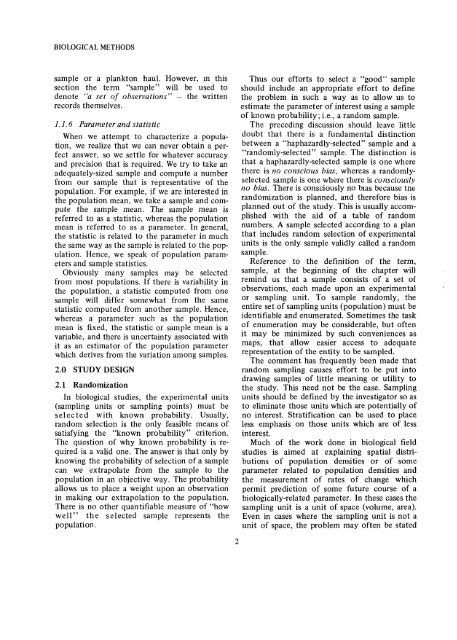Biological field and laboratory methods for measuring the quality of ...
Biological field and laboratory methods for measuring the quality of ...
Biological field and laboratory methods for measuring the quality of ...
You also want an ePaper? Increase the reach of your titles
YUMPU automatically turns print PDFs into web optimized ePapers that Google loves.
BIOLOGICAL METHODS<br />
sample or a plankton haul. However, m this<br />
section <strong>the</strong> term "sample" will be used to<br />
denote "a set <strong>of</strong> observations" - <strong>the</strong> written<br />
records <strong>the</strong>mselves.<br />
1.1.6 Parameter <strong>and</strong> statistic<br />
When we attempt to characterize a population,<br />
we realize that we can never obtain a perfect<br />
answer, so we settle <strong>for</strong> whatever accuracy<br />
<strong>and</strong> precision that is required. We try to take an<br />
adequately-sized sample <strong>and</strong> compute a number<br />
from our sample that is representative <strong>of</strong> <strong>the</strong><br />
population. For example, if we are interested in<br />
<strong>the</strong> population mean, we take a sample <strong>and</strong> compute<br />
<strong>the</strong> sample mean. The sample mean is<br />
referred to as a statistic, whereas <strong>the</strong> population<br />
mean is referred to as a parameter. In general,<br />
<strong>the</strong> statistic is related to <strong>the</strong> parameter in much<br />
<strong>the</strong> same way as <strong>the</strong> sample is related to <strong>the</strong> population.<br />
Hence, we speak <strong>of</strong> population parameters<br />
<strong>and</strong> sample statistics.<br />
Obviously many samples may be selected<br />
from most populations. If <strong>the</strong>re is variability in<br />
<strong>the</strong> population, a statistic computed from one<br />
sample will differ somewhat from <strong>the</strong> same<br />
statistic computed from ano<strong>the</strong>r sample. Hence,<br />
whereas a parameter such as <strong>the</strong> population<br />
mean is fixed, <strong>the</strong> statistic or sample mean is a<br />
variable, <strong>and</strong> <strong>the</strong>re is uncertainty associated with<br />
it as an estimator <strong>of</strong> <strong>the</strong> population parameter<br />
which derives from <strong>the</strong> variation among samples.<br />
2.0 STUDY DESIGN<br />
2.1 R<strong>and</strong>omization<br />
In biological studies, <strong>the</strong> experimental units<br />
(sampling units or sampling points) must be<br />
selected with known probability. Usually,<br />
r<strong>and</strong>om selection is <strong>the</strong> only feasible means <strong>of</strong><br />
satisfying <strong>the</strong> "known probability" criterion.<br />
The question <strong>of</strong> why known probability is required<br />
is a valid one. The answer is that only by<br />
knowing <strong>the</strong> probability <strong>of</strong> selection <strong>of</strong> a sample<br />
can we extrapolate from <strong>the</strong> sample to <strong>the</strong><br />
population in an objective way. The probability<br />
allows us to place a weight upon an observation<br />
in making our extrapolation to <strong>the</strong> population.<br />
There is no o<strong>the</strong>r quantifiable measure <strong>of</strong> "how<br />
well" <strong>the</strong> selected sample represents <strong>the</strong><br />
population.<br />
2<br />
Thus our ef<strong>for</strong>ts to select a "good" sample<br />
should include an appropriate ef<strong>for</strong>t to define<br />
<strong>the</strong> problem in such a way as to allow us to<br />
estimate <strong>the</strong> parameter <strong>of</strong> interest using a sample<br />
<strong>of</strong> known probability; i.e., a r<strong>and</strong>om sample.<br />
The preceding discussion should leave little<br />
doubt that <strong>the</strong>re is a fundamental distinction<br />
between a "haphazardly-selected" sample <strong>and</strong> a<br />
"r<strong>and</strong>omly-selected" sample. The distinction is<br />
that a haphazardly-selected sample is one where<br />
<strong>the</strong>re is no conscious bias, whereas a r<strong>and</strong>omlyselected<br />
sample is one where <strong>the</strong>re is consciously<br />
no bias. There is consciously no bias because tne<br />
r<strong>and</strong>omization is planned, <strong>and</strong> <strong>the</strong>re<strong>for</strong>e bias is<br />
planned out <strong>of</strong> <strong>the</strong> study. This is usually accomplished<br />
with <strong>the</strong> aid <strong>of</strong> a table <strong>of</strong> r<strong>and</strong>om<br />
numbers. A sample selected according to a plan<br />
that includes r<strong>and</strong>om selection <strong>of</strong> experimental<br />
units is <strong>the</strong> only sample validly called a r<strong>and</strong>om<br />
sample.<br />
Reference to <strong>the</strong> definition <strong>of</strong> <strong>the</strong> term,<br />
sample, at <strong>the</strong> beginning <strong>of</strong> <strong>the</strong> chapter will<br />
remind us that a sample consists <strong>of</strong> a set <strong>of</strong><br />
observations, each made upon an experimental<br />
or sampling unit. To sample r<strong>and</strong>omly, <strong>the</strong><br />
entire set <strong>of</strong> sampling units (population) must be<br />
identifiable <strong>and</strong> enumerated. Sometimes <strong>the</strong> task<br />
<strong>of</strong> enumeration may be considerable, but <strong>of</strong>ten<br />
it may be minimized by such conveniences as<br />
maps, that allow easier access to adequate<br />
representation <strong>of</strong> <strong>the</strong> entity to be sampled.<br />
The comment has frequently been made that<br />
r<strong>and</strong>om sampling causes ef<strong>for</strong>t to be put into<br />
drawing samples <strong>of</strong> little meaning or utility to<br />
<strong>the</strong> study. This need not be <strong>the</strong> case. Sampling<br />
units should be defined by <strong>the</strong> investigator so as<br />
to eliminate those units which are potentially <strong>of</strong><br />
no interest. Stratification can be used to place<br />
less emphasis on those units which are <strong>of</strong> less<br />
interest.<br />
Much <strong>of</strong> <strong>the</strong> work done in biological <strong>field</strong><br />
studies is aimed at explaining spatial distributions<br />
<strong>of</strong> population densities or <strong>of</strong> some<br />
parameter related to population densities <strong>and</strong><br />
<strong>the</strong> measurement <strong>of</strong> rates <strong>of</strong> change which<br />
permit prediction <strong>of</strong> some future course <strong>of</strong> a<br />
biologically-related parameter. In <strong>the</strong>se cases <strong>the</strong><br />
sampling unit is a unit <strong>of</strong> space (volume, area).<br />
Even in cases where <strong>the</strong> sampling unit is not a<br />
unit <strong>of</strong> space, <strong>the</strong> problem may <strong>of</strong>ten be stated















